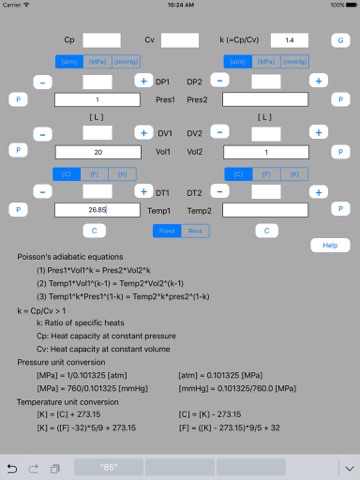
Adiabatic Calculator
Adiabatic process is a process in which heat exchange does not take place between a thermodynamic system and its surroundings. Behavior of reversible adiabatic process is described by Poissons equations. Adiabatic Calculator is a software that solves the Poissons equations. Its possible to change one of input data one after another. Thus its possible to get output data which correspond to the changed input data.
(Example)
There is air of 1 atmosphere ( = 0.1[MPa]) and 26.85[C]. When volume of the air is adiabatically compressed into 1/20, how do the temperature and the pressure change?
When the volume is compressed into 1/25, 1/30, and 1/35, how do they change?
Assume that ratio of specific heats of the air is 1.4
(Answer)
This software calculates output data based on one pair data of initial and final state. Ratio of the pair data is used for the calculation.
In this example, pair data is initial and final volumes
Enter pair data as follows.
Vol1 = 20[L], Vo12 = 1[L]
Enter other known data as follows.
Pres1 = 1[atm]
Temp1 = 26.85[C]
Enter ratio of specific heats as follows.
k = 1.4
To execute calculation, P button of the pair data is touched out. There are initial side and final side P buttons for the pair data. Which side button to select depends on calculation mode.
In this example, we want to get Pres2 and Temp2 data that correspond to changed Vol1 data. Output data is opposite side to the input data. In this case, set calculation mode to Fowd mode.
Touch out Vol1_P button.
We obtain 66.3[atm] and 721.2[C] as the final pressure and the final temperature , respectively.
Next enter increment data as follows.
DV1 = 5[L]
Touch out + button.
For the volume compression into 1/25, we obtain 90.6 [atm] and 814.0[C] as the final pressure and the final temperature.
Next touch out + button. We can obtain the next output data.
By use of + or - button, its possible to change one of input data one after another and to get output data which corresponds to the changed input data.



